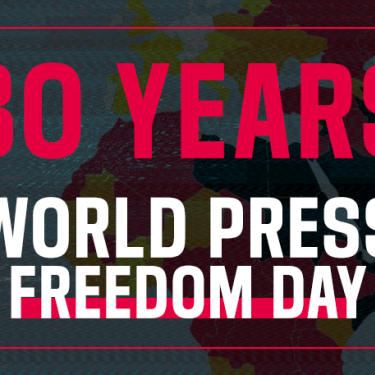How RSF invented World Press Freedom Day on 20 April 1991

In 1993, the United Nations General Assembly proclaimed 3 May as World Press Freedom Day, following a recommendation made by UNESCO in November 1991. An event will be held at UN headquarters in New York on 2 May to mark the 30th anniversary. But, in fact, Reporters Without Borders (RSF) organised the first Press Freedom Day with UNESCO support in 1991. We look back at the history of this important annual event.
According to the official history, it was a declaration on 3 May 1991 by 60 or so African journalists gathered in Windhoek, Namibia, that called for the creation of a World Press Freedom Day. But, in reality, RSF organised the first international press freedom day 13 days before that, thereby inspiring the celebration now held every year.
In 1991, RSF was still a small NGO. Created eight years earlier, it had eight fulltime employees who had just published a “round-up of journalists killed throughout the world.” Nonetheless, this was the precise moment that the young RSF established the basis of what would become an important day for journalism – the World Press Freedom Day now celebrated throughout the world on 3 May.
The subjects covered by RSF in the spring of 1991 were overshadowed by rather dramatic international news stories in Iraq and Yugoslavia. To make your voice heard, you had to create an event. Establishing a day seemed to be the only way to draw attention to the state of press freedom in the world, even if only for 24 hours. On 20 April 1991, the NGO that issued press releases about press freedom violations became an advocacy organisation.
In its issue of 19 April 1991, the French daily Le Monde reported: “In response to RSF’s appeal, most of the leading French media will mobilise on 20 April for the first International Press Freedom Day. Video and audio clips about journalists in prison will be broadcast by TV and radio stations, while newspapers will dedicate editorials and Saturday columns to press freedom. Everyone is urged to adopt an imprisoned journalist.”
The first Annual Press Freedom Report, the ancestor of the World Press Freedom Index, was published the same day. Ad agencies were enlisted to ask prominent figures to speak out on behalf of imprisoned journalists. The day was sponsored by several well-known people including deputy communication minister, Catherine Tasca, and then UNESCO director-general Federico Mayor.
One of the recommendations of UNESCO’s General Conference in November 1991 was the creation of an International Press Freedom Day in response to the appeal by the African Journalists in Windhoek, known as the Windhoek Declaration, which did not mention RSF. The following year, RSF adopted UNESCO’s proposal to move the event to 3 May, after a German official at UNESCO pointed out that 20 April was Adolf Hitler’s birthday.
The Windhoek Declaration’s date was chosen for the World Press Freedom Day that the UN General Assembly formally proclaimed in 1993 – a proclamation that has given the event the weight, legitimacy and universality that it enjoys today. To mark the day this year, UNESCO is organising an event in New York entitled “Shaping a Future of Rights. Freedom of expression as a driver for all other human rights.”
On 3 May, RSF will unveil the latest World Press Freedom Index, regarded as an authoritative annual evaluation of the environment for journalism in 180 countries and territories. In Washington DC, it will be unveiled at an event co-hosted by Washington Post Live that US Secretary of State Antony Blinken is scheduled to join.
